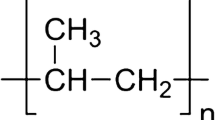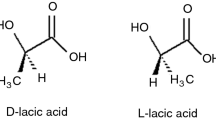Abstract
A series of polyurethane networks were prepared from MDI (4,41-diphenyl methane diisocyanate), ethylene glycol and a polyoxyethylene-tipped polyoxypropylene triol. The phase separation and phase inversion phenomena of these polyurethane networks were investigated by differential scanning calorimetry (DSC), dynamic mechanical analysis (DMA) and measurement of their tensile properties. The DSC and DMA data indicate that the segmented copolyurethanes possess a two-phase morphology comprising soft and hard segments. It can be found from DSC data that the polyether soft segments exhibit a Tg (glass transition temperature) of −60 °C, and the aromatic hard segments display a Tg of about 128 °C. Two Tgs corresponding to the comprised segments can also be found by DMA for some segmented polyurethanes. Varying the content of aromatic hard segments over the range from 0 to 80 wt% changes the material behavior from a soft rubber through a highly extensible elastomer to a brittle semi-ductile glassy material. Based on the property-composition plots, phase inversion appears to occur at a hard segment content of about 50 wt%.
Similar content being viewed by others
References
J. W. C. Van Bogart, A. Lilanonitkul and S. L. Cooper,Multiphase Polymers (Ed. S. L. Cooper), ACS, New York, 1979, p. 1.
R. J. Zdrahala, S. L. Hager, R. M. Gerkin and F. E. Critchfield,J. Elast. Plast.,12, 225 (1980).
S. Abouzahr, G. L. Wikes and Z. Ophir,Polymer,23, 1077 (1982).
N. Barksby, D. Dunn, A. Kaye, J. L. Stanford and R. F. T. Stepto,Reaction Injection Moulding (Ed. J. E. Kresta), ACS, 1985, New York, p. 85.
A. J. Ryan, C. W. Macosko and W. Bras,Macromolecules,25, 6277 (1992).
W. Hu and J. T. Koberstein,J. Polym. Sci., Polym. Phys.,32, 437 (1994).
R. M. Brider and E. L. Thomas,J. Macromol. Sci. Phys.,B22, 553 (1983).
G. Oertel,Polyurethane Handbook, Hanser Publishers, New York, 1985.
W. R. Sorenson and T. W. Campbell,Preparative Methods of Polymer Chemistry, Interscience Publishers, New York, 1961.
J. M. G. Cowie,Polymers: Chemistry and Physics of Modern Materials, Intertext Book, London, 1973.
D. J. David and H. B. Staley,Analytical Chemistry of Polyurethanes, Vol.XVI, Part 3, Wiley-Interscience, New York, 1965.
R. S. Seymour and S. L. Cooper,Macromolecules,6, 48 (1973).
S. Abouzahr, G. L. Wilkes and Z. Ophir,Polymer,23, 1077 (1982).
R. J. Zdrahala, R. M. Gerkin, S. L. Hager and F. E. Critchfield,J. Appl. Polym. Sci.,24, 2041 (1979).
Author information
Authors and Affiliations
Rights and permissions
About this article
Cite this article
Lee, DK., Tsai, HB. & Standford, J.L. Phase separation and phase inversion of polyurethane networks. J Polym Res 3, 159–163 (1996). https://doi.org/10.1007/BF01494525
Issue Date:
DOI: https://doi.org/10.1007/BF01494525




